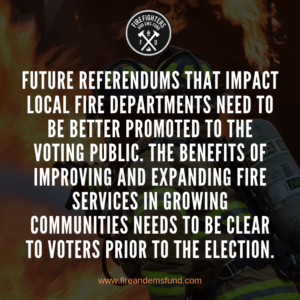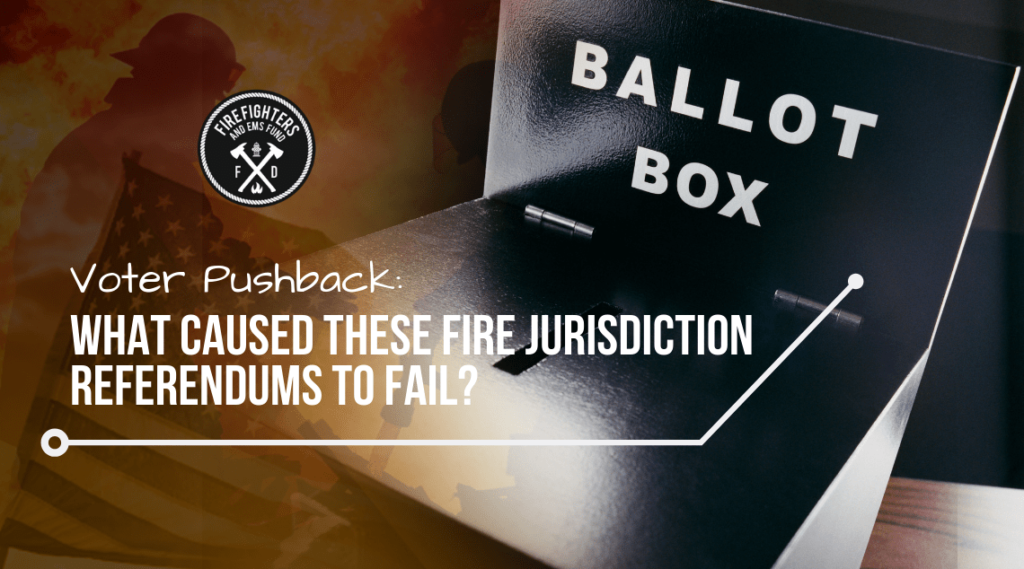During a 2018 study of ballot measures passed and failed in regard to fire jurisdictions and their needs, several interesting points of data came to light. As the Firefighter and EMS Fund continues to shed light on the support needs of fire jurisdictions and emergency medical service providers, it’s important to take a deeper look at why certain measures met higher levels of resistance from voters.
In the study conducted of 62 referendums, primarily in California, Colorado, and Illinois, we found that the majority of the measures presented passed. However, some measures saw a higher level of pushback. Interestingly, the category that saw the most voter resistance was that of the idea of new fire stations.
Many factors contribute to the need for a new fire station in town. In many areas of the country, particularly in California, the increased threat of natural disaster such as wildfires has brought a heightened need for fire protection. With this need comes an increase in demand for fully staffed and operational fire stations. In these cases, stations that are old, outdated, or otherwise in improper working order are under-equipped to handle a higher level of demand.

In other cases, mere population increase is enough to warrant the addition of a new station or the updating of an existing station. In these instances, the station is often understaffed and unable to deal with the increased demands from a denser population.
And yet other examples include fire jurisdictions who, in the face of relentless budget cuts over the years, have had to lay off staff and cut costs. Now, as the population numbers surge and the risk of fire and damage increases accordingly, the need arises for an improvement to existing facilities or the building of new stations.
Why, then, are voters seemingly more resistant to these types of measures specifically?
In the case of the Pingree, Illinois fire department, disappointed backers saw a referendum to build new stations fail for a third time. This was a request to borrow $8.5 million to build two new fire stations, but the referendum met with resistance and was once again voted down.
The reasoning behind this? “We need to serve our population where it is and where it will be,” Pingree board president John Payson said. “As far as being a trustee, it’s my responsibility as a taxpayer to spend their money wisely, and in my mind, this is what I really think we’re doing.” Indeed, the referendum narrowly made it onto the ballot in the first place, and it seems that voters followed suit by not passing the bill.
In some instances, such as that of the Pingree fire department, it seems that voters and public officials did not feel that the proposed improvements were in the right areas or utilizing the right amount of budget.
Interestingly, the amount of property tax increase proposed on the majority of the facility and staffing related ballot measures was minimal. It would appear that the fire departments did what they could to stay conservative on their ask — even simply asking for budget to maintain operation levels, not increase or expand them.
A lack of perceived need may also be a contributing factor in the voter pushback. Many voters will balk at a tax increase of any sort, particularly if the measure does not appear to affect them or their community personally. This is an unfortunate side effect of lack of voter education.
Future referendums may need to be promoted better to the voting public, publicizing the benefits of improving and expanding fire services in neighborhoods that need them the most. Perhaps this approach will be a way forward for improving the passing percentage of these important ballot measures affecting emergency services all over the country.
Our 2018 Fire Referendum Report provides some interesting analysis that fire jurisdictions will need to know in order to successfully request funding from voters. Click here to download the full report.








